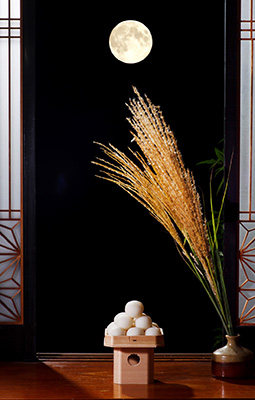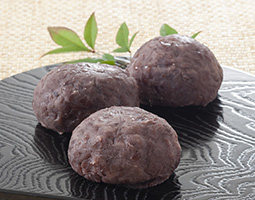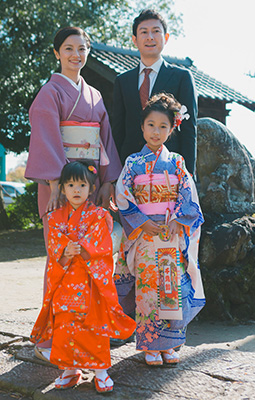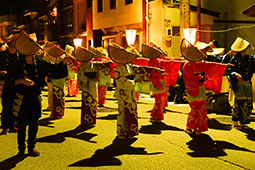September 2022
- English
- 日本語
Autumn in Japan

Miura Yasuko 
Autumnal Ryuokyo gorge in Nikko City, Tochigi Prefecture

A display of tsukimi dango (moon-viewing rice dumplings) and Japanese pampas grass on the occasion of “Chushu no Meigetsu” (Mid-autumn moon) 
Ohagi rice dumplings covered with sweet red been paste, a treat enjoyed and offered at the time of higan around the autumn equinox 
A family with a child (right) holding chitose-ame candy on shichi-go-san, a ceremonial event in mid-November for children aged seven, five and three 
Men and women dancing in the street during the Owara Kaze no Bon festival held in early September in Yatsuo town, Toyama City, Toyama Prefecture

We spoke with Miura Yasuko, a researcher of Japanese culture, about the scenery, events, customs, and foods of autumn in Japan.

How do people picture the season of autumn in Japan?
In Japan, there are some set phrases for describing autumn. One example is “fruitful autumn.” This is because in autumn various crops bear fruit and the harvest season arrives. Because of the abundance of ingredients, there are many delicious dishes in autumn. For this reason, it is also known as “good appetite autumn.” Moreover, autumn features pleasant temperatures and the weather is relatively stable. Because it is a good season for outdoor activities, it is also described as “sports autumn” or “vacation autumn.” In any case, for most Japanese people autumn in Japan is a season with many things to look forward to, including food and events that enable them to experience the blessings of nature.
What natural changes make people feel that it’s autumn in Japan?
In September, various insects such as pine crickets and bell crickets begin to chirp. When Japanese hear these “singing” insects, they feel the arrival of autumn, thinking, “The heat of summer is over, and it is finally getting cooler.” In The Tale of Genji, a long novel with aristocratic society as its setting written by Murasaki Shikibu in the early eleventh century, there are scenes describing the singing of insects in autumn. Internationally, there are almost no countries outside Japan and the rest of East Asia that have a culture of enjoying the singing of insects.
In October, you can also feel autumn in the trees along the streets and in the mountains as they begin to change color. In Japan, you can see beautiful autumn leaves all over the country. This is because about two-thirds of the country’s land area is covered with forest, and there are many deciduous trees with autumn leaves. Since ancient times, Japanese people have loved the beauty of autumn leaves in the same way as they do the plum and cherry blossoms in spring. The Man’yoshu, Japan’s oldest anthology of poems, which is said to have been compiled from the second half of the seventh century, contains about 100 waka* poems on the theme of autumn leaves. Moreover, during the Heian period (end of the eighth century to the end of the 12th century), nobles held events where they enjoyed the autumn leaves and competed in waka poem creation contests.
What are the major events that take place in autumn in Japan?
For example, we have the autumn festivals. Among the crops harvested in autumn, rice has been particularly important to Japanese people since ancient times. Therefore, in autumn, festivals are held all over the country to thank the deities for the harvest. Rice harvested that autumn is offered in the rituals held at shrines. There are areas where people carry mikoshi, small portable shrines for the transport of deities, in a procession around the town, or they perform kagura**, which is a musical theater dedicated to the deities, at the local shrine.
Moreover, tsukimi (moon viewing) is held to appreciate “Chushu no Meigetsu” (Mid-autumn moon) around the middle of September. Chushu means the day August 15 or jugoya (the fifteenth night) according to the old calendar of Japan (lunisolar calendar).*** According to this calendar, autumn is between July and September and Chushu is just the middle of Autumn. On Chushu, which is also jugoya, the sky was clear and the moon was at its most beautiful. Therefore, tsukimi is said to have originated among the nobles of the Heian period when they held banquets while appreciating the moon. As the enjoyment of tsukimi spread to the general public, it turned into an event to give thanks to the moon by making offerings of the autumn harvest at home. People knew the date by the phases of the moon and spent the nights relying on the moonlight. The moon, like the sun, was important to the people of long ago. There are differences between regions and households, but typically at tsukimi, three main offerings are prepared as decorations. They are autumn harvests such as satoimo (a type of taro), sweet potatoes, grapes, and pears, tsukimi dango (rice dumplings) resembling a full moon, and Japanese pampas grass. Stems of pampas grass, which resemble the ears of rice, are thought to be a dwelling place of the deities.
What other events are there in autumn in Japan?
Grave visits are made on the days known as higan. Higan occurs twice a year, in spring and autumn. Higan in autumn is around September 23, covering the autumn equinox, when the length of day and night is the same, as well as the day before and after. On the autumn equinox, the sun rises due east and sets due west. Therefore, it is thought to be the days of the year when “that world” called higan in the west where our ancestors live is the most connected to “this world” called shigan in the east where we live. For this reason, many people visit the graves of their ancestors on higan to pay their respects. On higan in autumn, we eat ohagi and offer the sweet to our ancestors at their graves. The name of the sweet is said to come from the flower of hagi (Japanese bush clover), which blooms in the autumn. It is a sweet food made by forming cooked and pounded rice into a ball and covering it with red bean paste to which sugar has been added. In the old days, sugar was a precious commodity in Japan, so ohagi was a real treat. It is said that this is why it became an item to be offered on the special day higan.

Also, on November 15 in late autumn, there is the event shichi-go-san, when we pray for the healthy growth of boys and girls aged three (san in Japanese) as well as boys aged five (go) and girls aged seven (shichi). In the past, the survival rate of infants was low, and it could be difficult to raise children until the age of seven. For this reason, this event came to be held to thank the deities and pray for the children’s healthy growth. On this day, children of each age wear traditional kimonos and visit the shrine with their families. On shichi-go-san, you can eat a candy called chitose-ame. The word “chitose” means “one thousand years” or “a long time.” Chitose-ame has a very elongated shape, expressing a wish for the child to live a long life. The color of the candy is red and white, a color combination that is considered auspicious. The bag containing the candy also has auspicious pictures such as pine, bamboo, and plum trees as well as cranes and turtles, which are associated with longevity.

What are some of the unique flavors of autumn in Japan?
One of the most popular autumn flavors is saury. In autumn, saury caught in the Pacific Ocean off the coast of Hokkaido and Tohoku in northern Japan are very fatty. Fresh saury is delicious to eat as sashimi, but it’s best to grill it with salt. Grilled saury is often eaten with grated daikon radish with soy sauce. People like the fine balance between the rich taste of the fatty saury and the refreshing taste of grated radish.
Autumn is also the season for satoimo taro. At the time of tsukimi, we offer and eat a dish called kinukatsugi. Kinukatsugi is a dish in which satoimo are boiled, peeled, and seasoned with salt and other condiments. There is also a dish using satoimo called imoni. Imoni is a mixture of ingredients such as satoimo, leeks, meat, and konnyaku**** simmered with seasonings such as soy sauce or miso. In areas such as Yamagata and Miyagi Prefectures, imoni parties are an autumn tradition. Family and friends gather and boil satoimo in a large pot on the dry river beds.
Autumn is also a season of delicious mushrooms. There are more than 5,000 species of mushrooms in Japan, and about 100 of them are said to be edible. Mushrooms can be eaten in various ways, such as baking, boiling, and stir-frying. The most precious and expensive of the mushrooms are matsutake. Matsutake mushrooms are difficult to cultivate artificially, so only wild-growing matsutake exist. Moreover, the harvesting period is short, and their numbers are small. The aroma of matsutake mushrooms is especially wonderful. You can enjoy that wonderful aroma and flavor whether you grill them, cook them with rice as matsutake gohan (rice), or batter and fry them as tempura.
Once the spread of COVID-19 subsides, how would you like visitors from overseas to enjoy autumn in Japan?
I would like them to see the autumn colors. The scenery of gardens of shrines and temples, and mountains steeped in red and yellow is exquisite. There are many places to see the autumn leaves, but one of my recommendations is Ryuokyo gorge in Nikko City, Tochigi Prefecture. The entire gorge through which the Kinugawa River flows is painted with autumn colors, making it a truly wonderful view.

Many famous autumn festivals are also held. For example, in September and October, the Kishiwada Danjiri Festival, which has an impressive history of 300 years, is held in Kishiwada City, Osaka Prefecture. Floats called danjiri are energetically towed around town by the people. In early November, Karatsu Kunchi***** is held in Karatsu City, Saga Prefecture. At this festival, fourteen huge and gorgeous floats called hikiyama tour the town.
Among the various autumn festivals, one I recommend especially is the Owara Kaze no Bon held in early September in Yatsuo town, Toyama City, Toyama Prefecture. This festival, which goes back more than 300 years, has men and women with braided hats doing a dancing walk to the tune of the local folk song Ecchu-Owara-Bushi and melancholic melody of the kokyu******. Many of the dancers are people who have been practicing the dance since childhood as they were born in this area. You can see amazing dances, such as the graceful dance of the women and the majestic dance of the men.

Also, I would like them to see the shichi-go-san event I mentioned earlier. I feel happy when I see the children happily wearing kimonos and the families watching over them. The customs and events of Japan are also meant to thank and pray for things that support us, and play roles in deepening bonds within family and community, fostering people’s sense of morality. Once you know the meaning of each custom and event, you will enjoy them even more.
- * See Highlighting Japan October 2020, “The Colors of Fall Captured in Waka Poetry” https://www.gov-online.go.jp/eng/publicity/book/hlj/html/202010/202010_02_en.html
- ** See Highlighting Japan November 2015, “A Dance Fit for the Gods” https://www.gov-online.go.jp/eng/publicity/book/hlj/html/201511/201511_02_en.html
- *** The lunisolar calendar is based on the phases of the moon and the cycles of the sun. It was used in Japan until 1872. Compared to our calendar today, it is about one month off.
- **** See Highlighting Japan June 2022, “An Ambassador for Japanese Food” https://www.gov-online.go.jp/eng/publicity/book/hlj/html/202206/202206_05_en.html
- ***** See Highlighting Japan November 2019, “A Festive Feast for Family and Friends” https://www.gov-online.go.jp/eng/publicity/book/hlj/html/201911/201911_05_en.html
- ****** The kokyu is a traditional Japanese stringed instrument.

